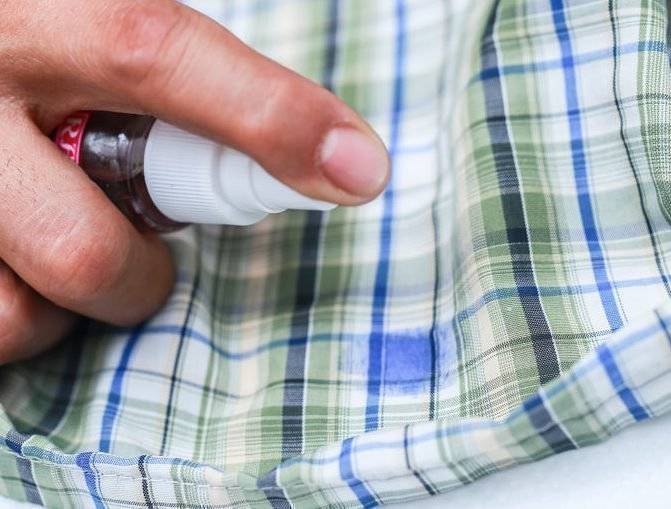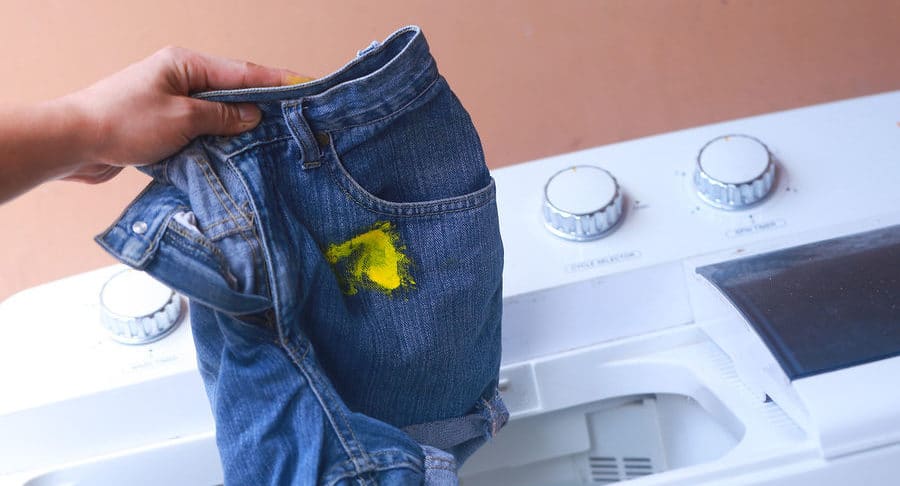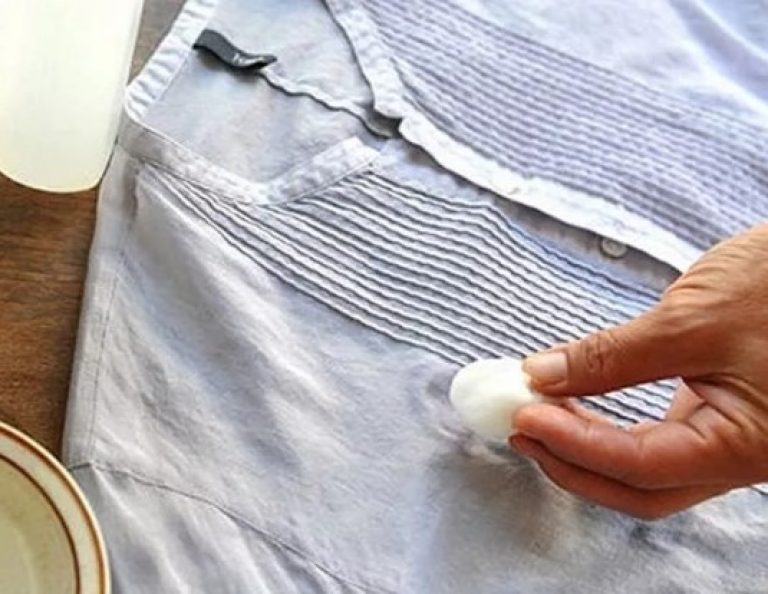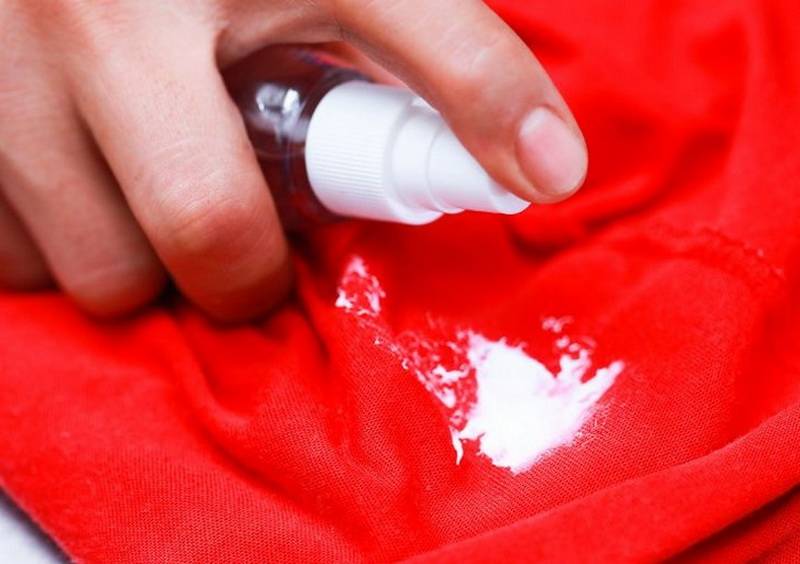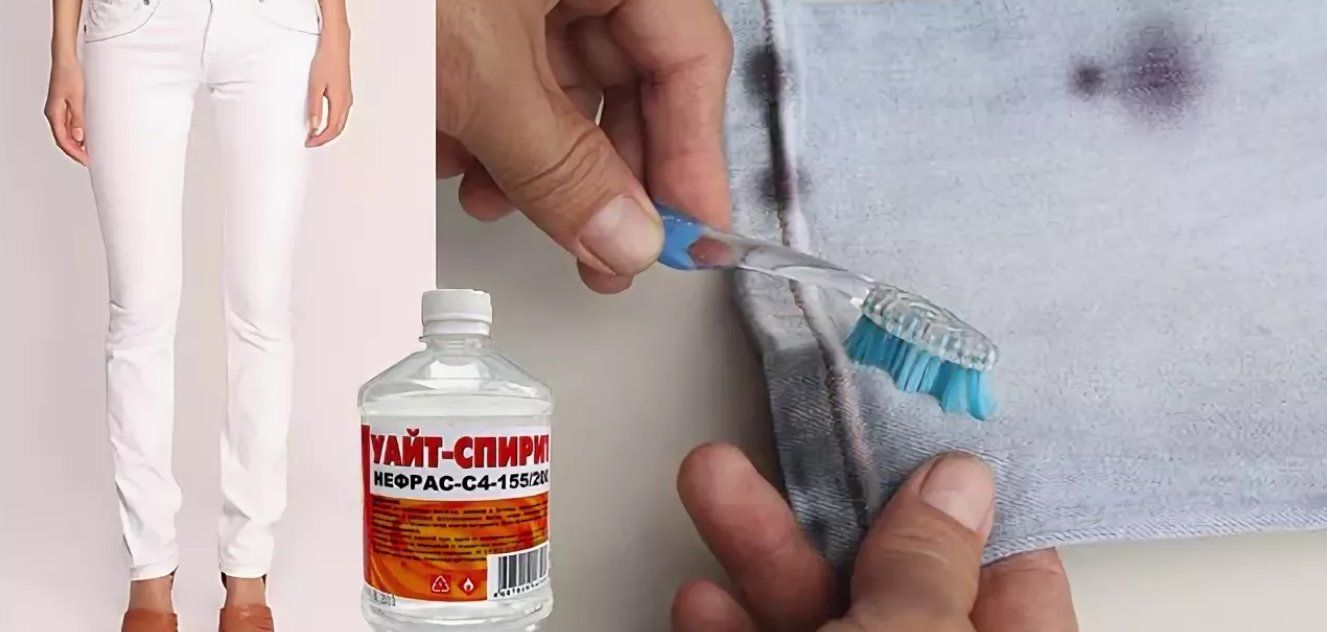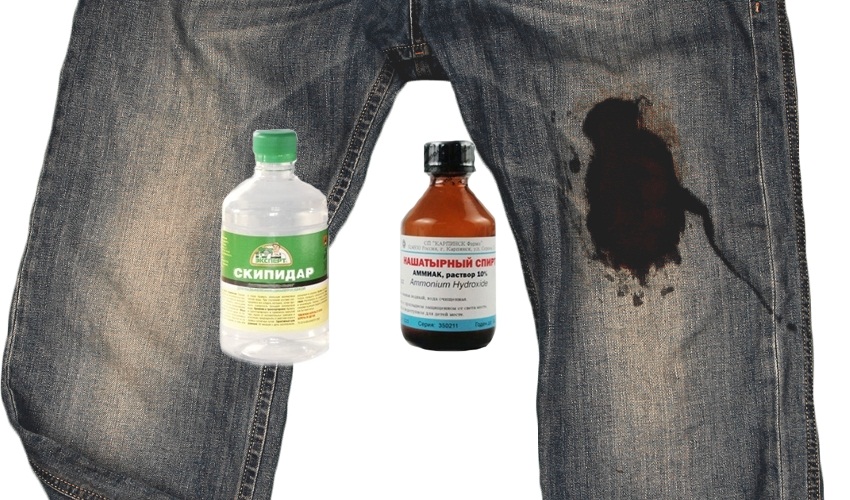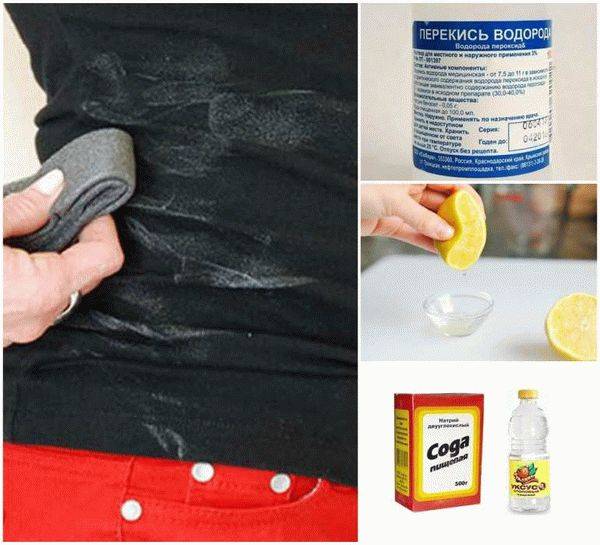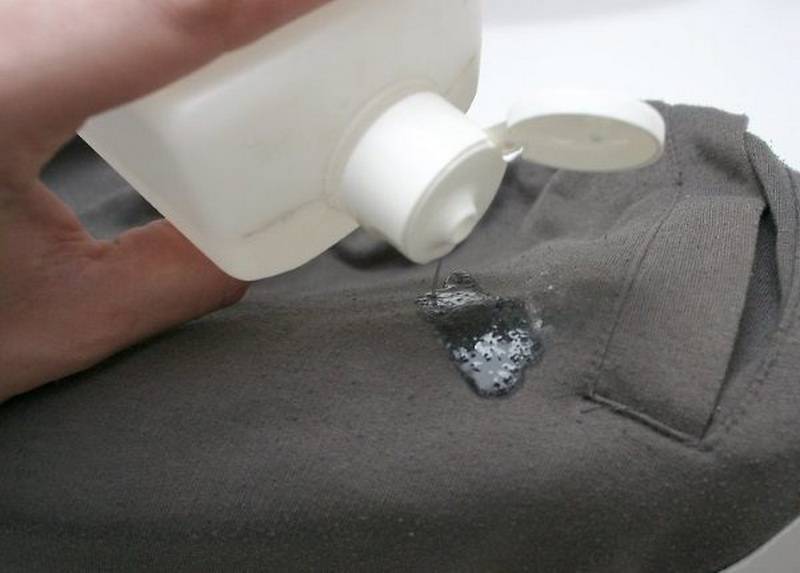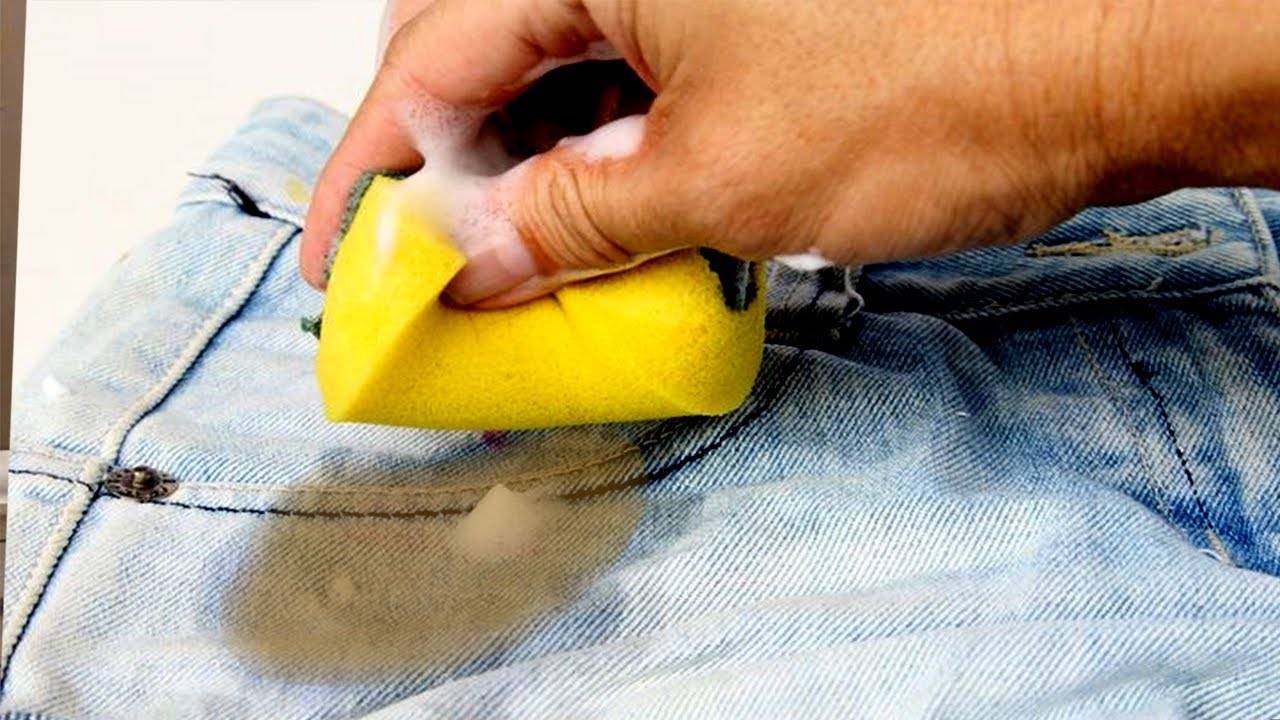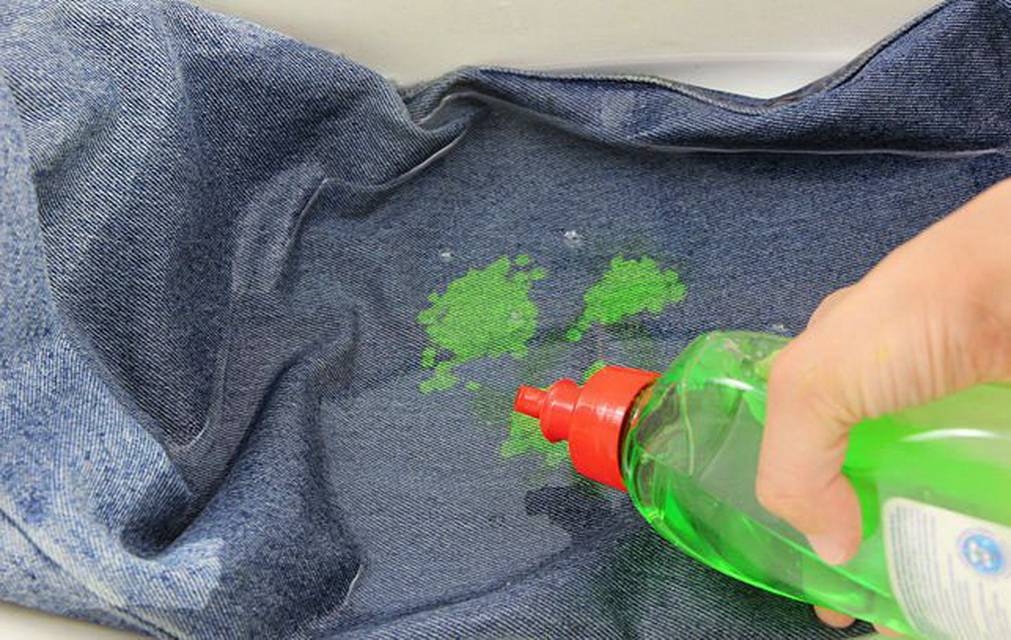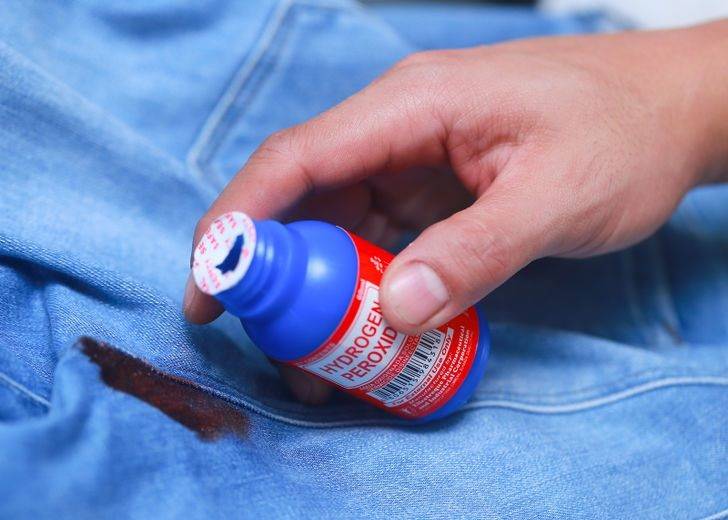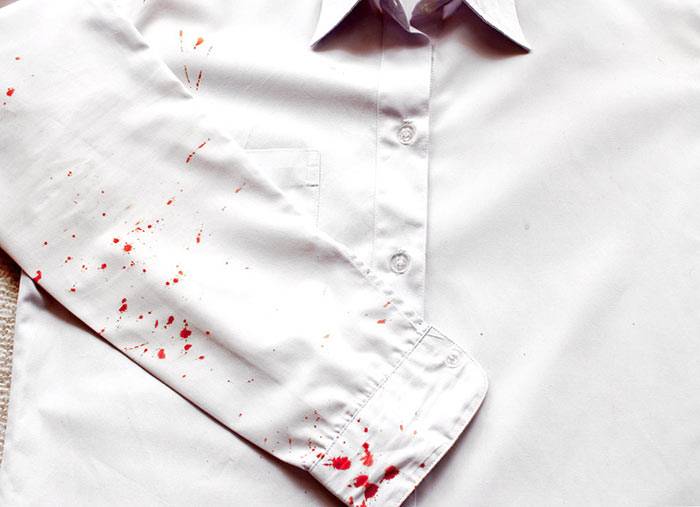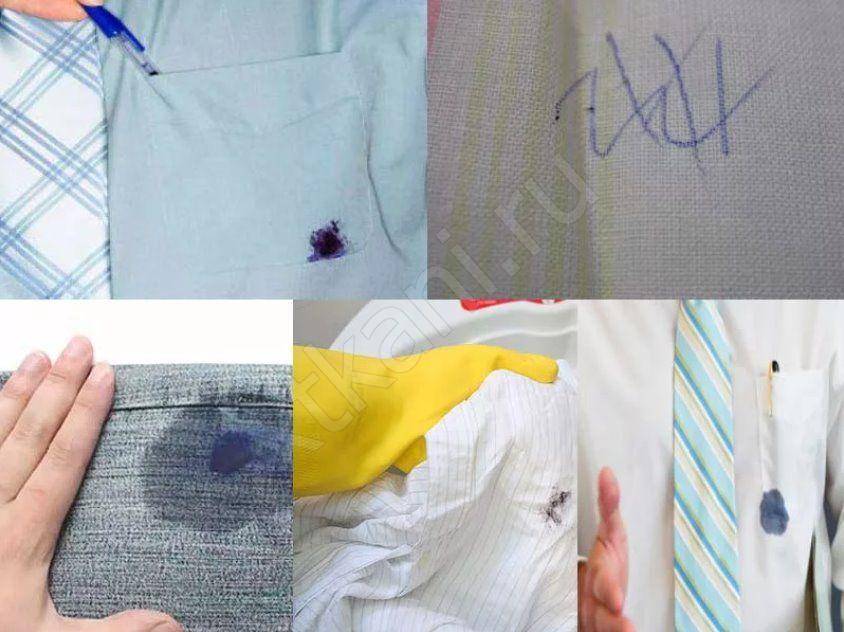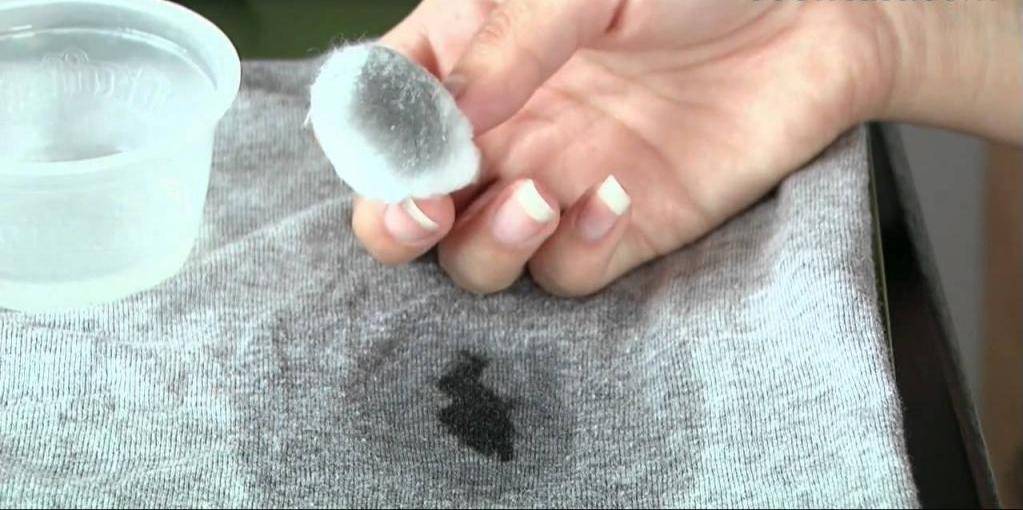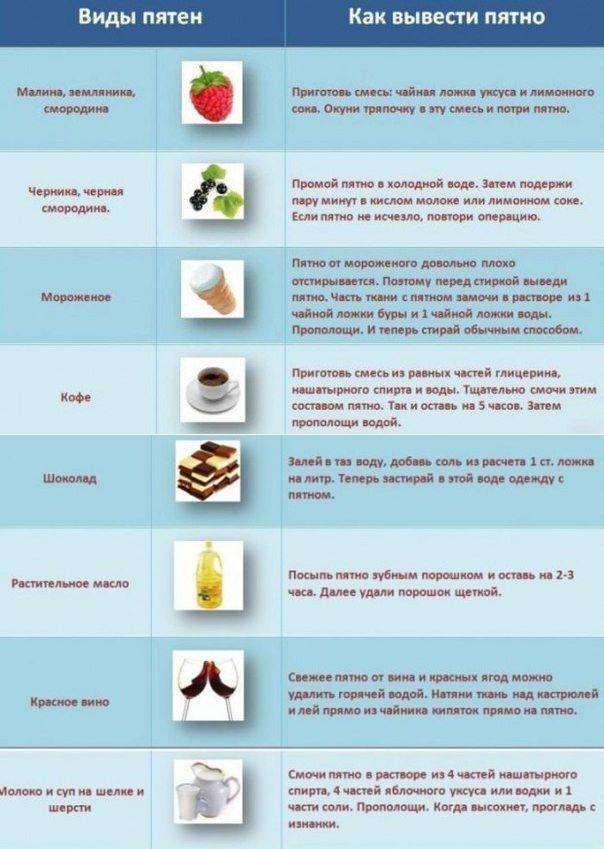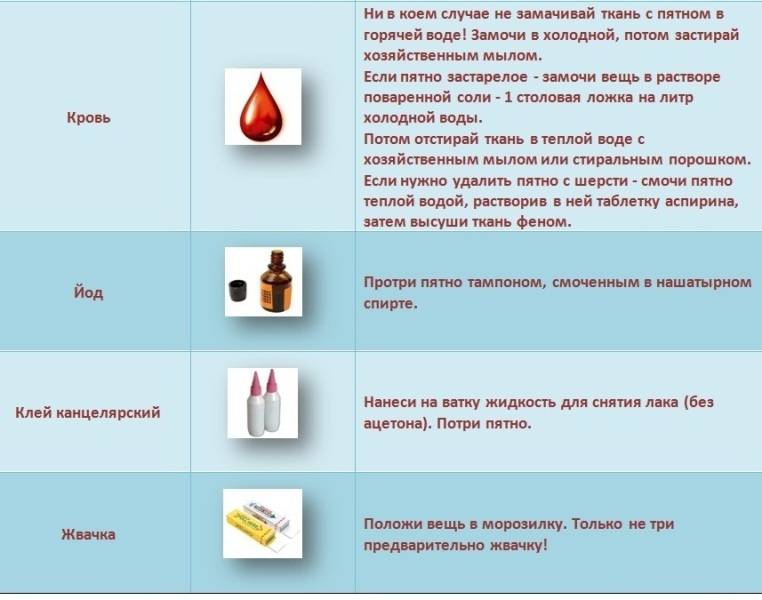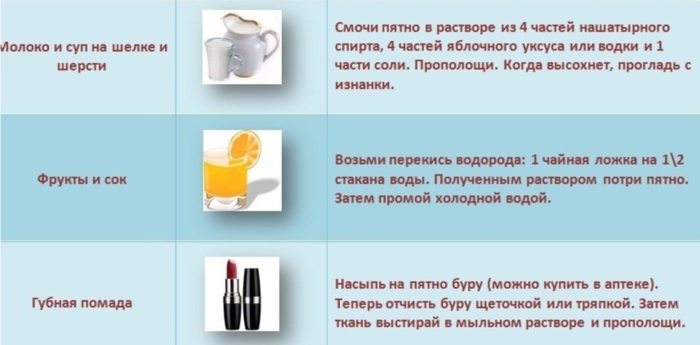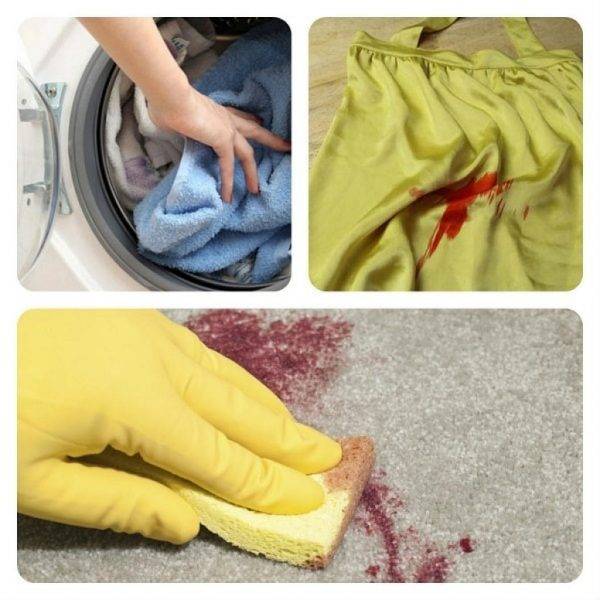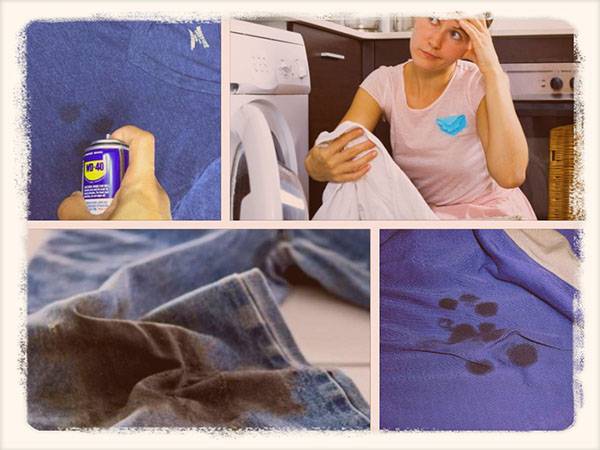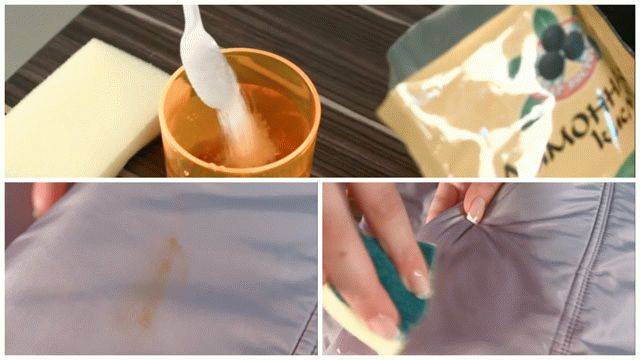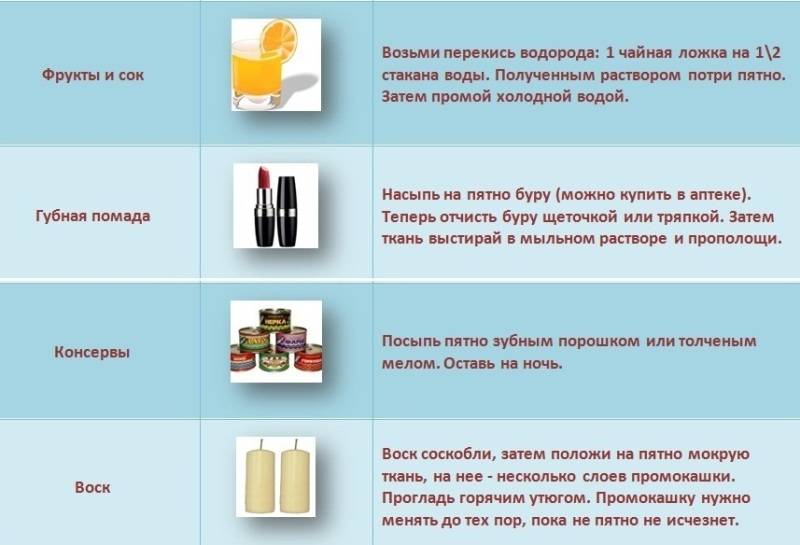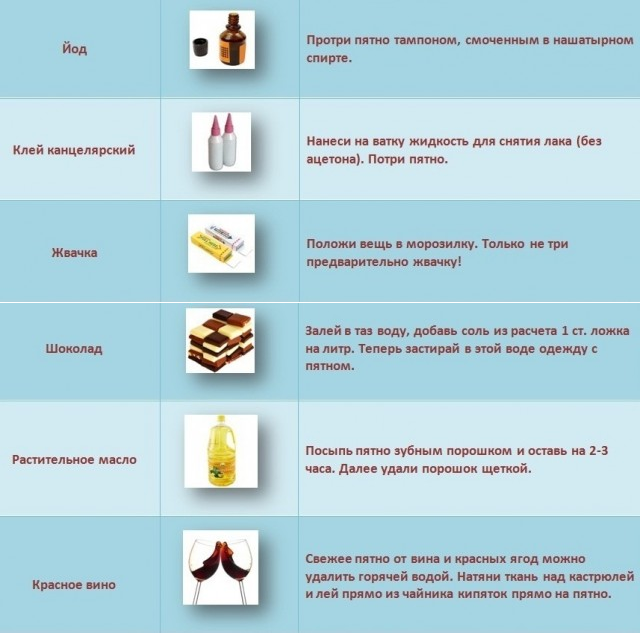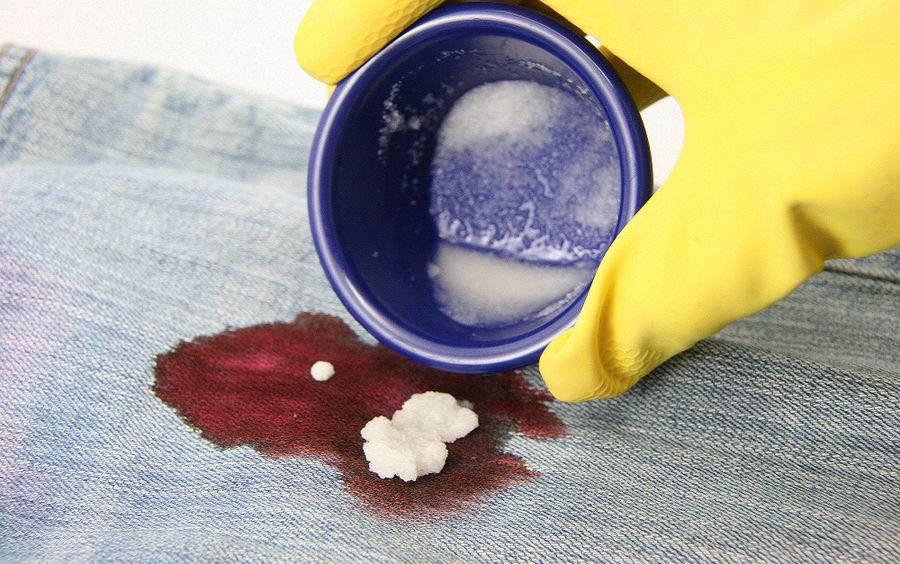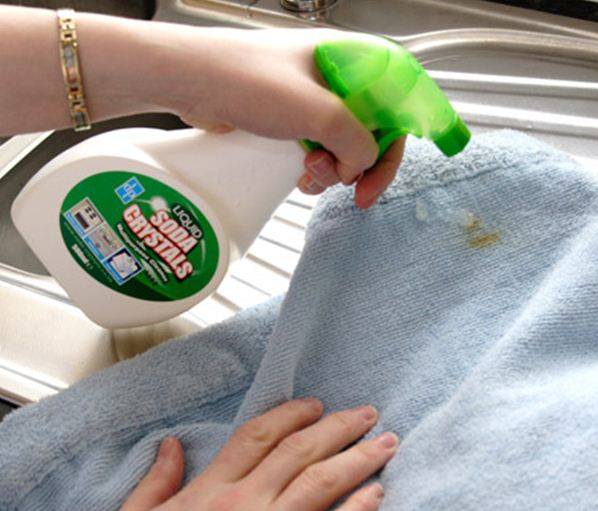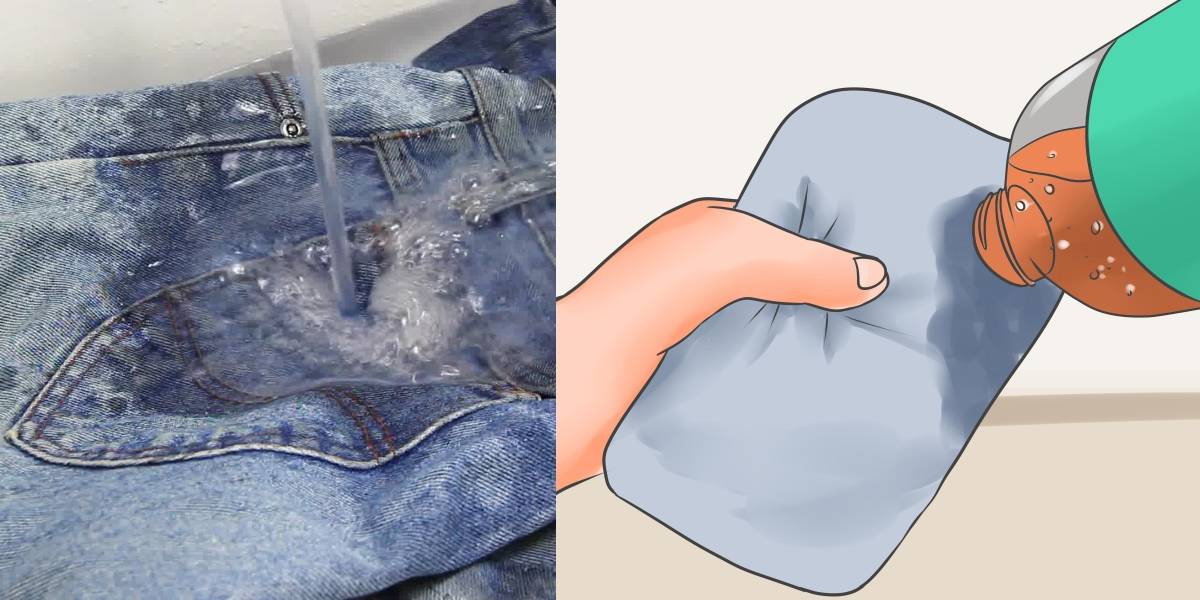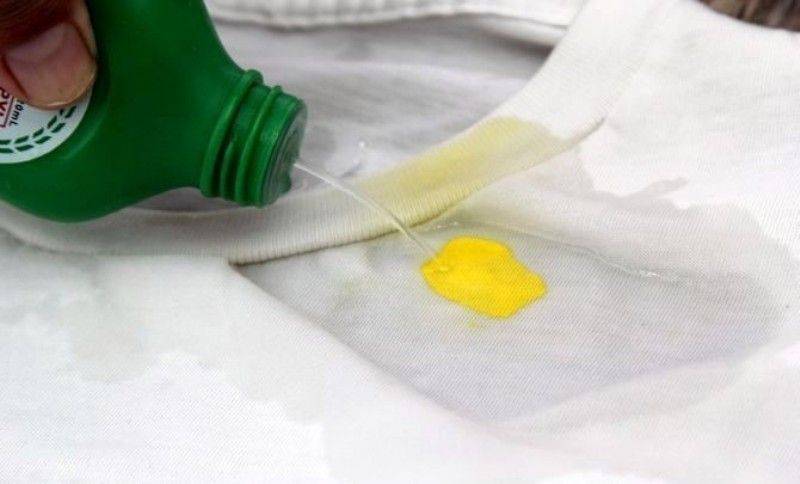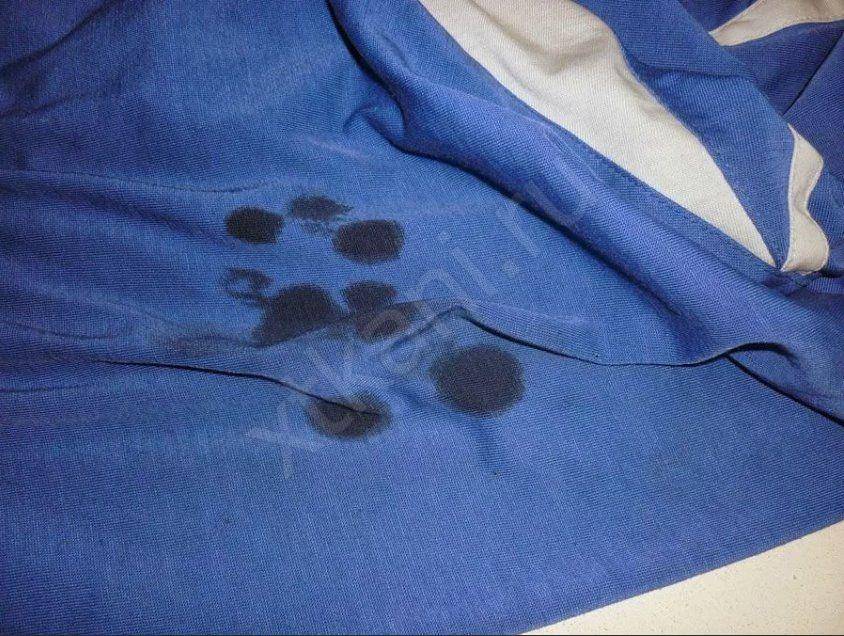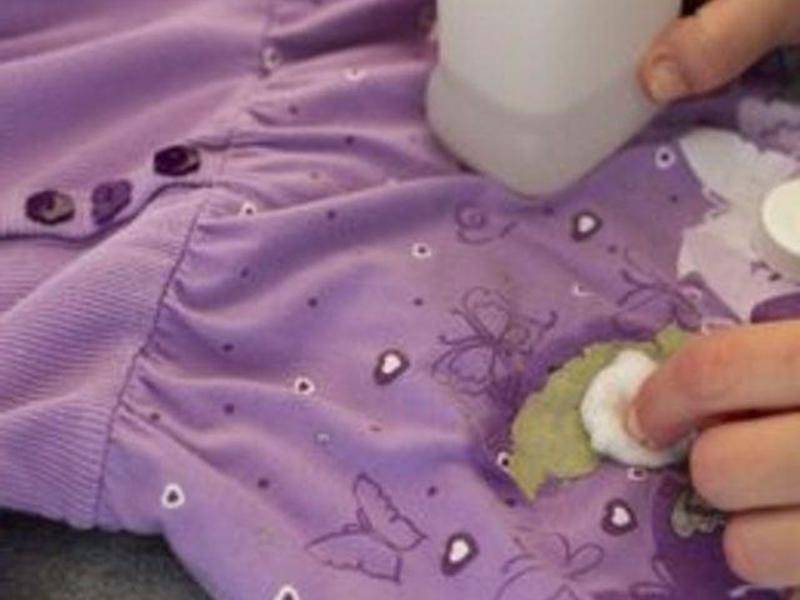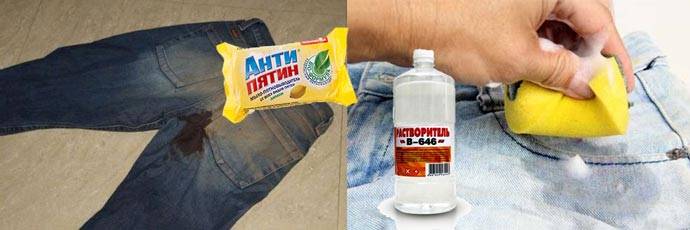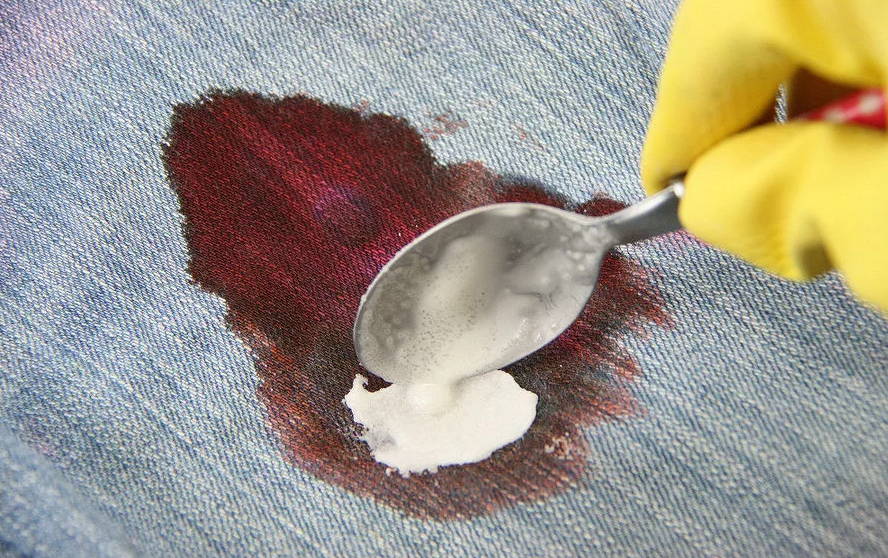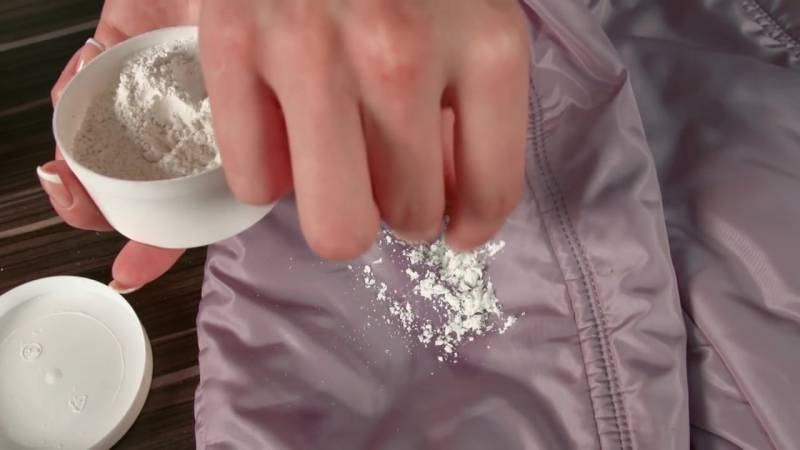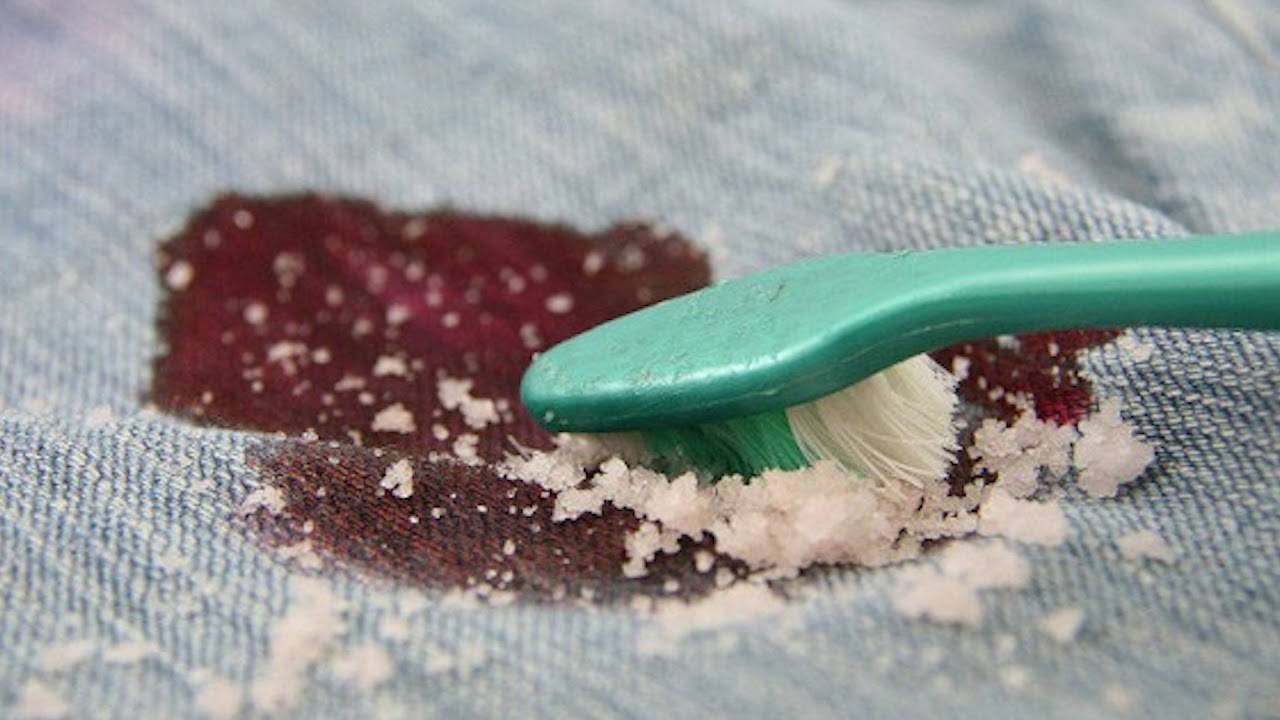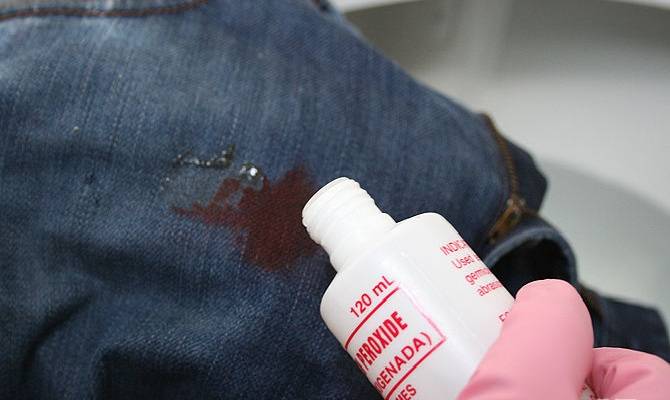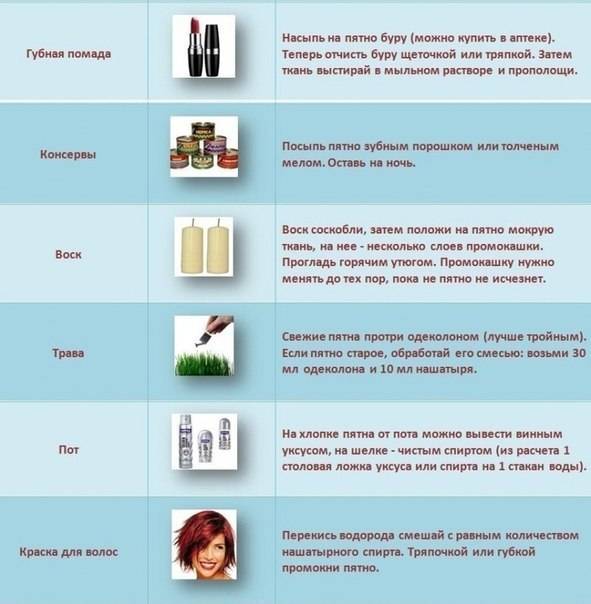Liquid dishwashing detergent
We are confident that this is the most readily available chemical in the home. Many people will be surprised that dishwashing gel is able to cope with many stubborn stains.
However, it should be noted that the colored liquid must be used with care, so the best option would be to remove stains from clothing with a colorless or white gel.
Removing stains with dishwashing gel:
- greasy stains on trousers, jeans, or a jacket
- removes traces of deodorant embedded in fabric
- removing sticky chewing gum from clothes
- cleaning of traces of blood from leather and greasy stains from fabric upholstery of upholstered furniture
- if there is an oil paint stain on the clothes
- elimination of traces of water-soluble markers
- dishwashing gel will remove fresh sweat stains from white shirts and cotton T-shirts
- helps to deal with old yellow spots on children's clothes
Undoubtedly, some of the housewives did not know about such a widespread use of dishwashing gel in everyday life, which can help a woman not only wash kitchen utensils, but also wipe off some complex dirt from fabrics.
How to remove old tar stains?
To remove old stubborn resin stains, solvents are used:
- ammonia;
- acetone or nail polish remover;
- rubbing alcohol or denatured alcohol;
- solvent 646 or 647;
- White Spirit;
- refined gasoline;
- turpentine;
- colorless cologne or eau de toilette.
For the processing to be successful, you need to follow a few simple rules:
- All procedures for removing resin contamination are carried out on the wrong side of the material, placing the thing on a support of napkins or cotton cloth with the face down.
- The area around the stain is slightly moistened with water to avoid streaks or halos around the area to be cleaned.
- The solvent is applied first to the contamination boundaries, and then, with gentle movements, move to the center.
- The contours of the stain are sprinkled with starch or talcum powder so that during cleaning the adsorbent will keep the fabric from further spreading dirt.
To remove resin using a solvent:
- apply the product to a cotton pad;
- apply to the spot for 15-20 minutes, until the liquid is completely dry;
- wipe the dissolved resin with a paper towel or clean cloth;
- once again apply a little product to the stain;
- rinse with hot water;
- wash with powder at the highest possible temperature, which is acceptable for the item being processed;
- if traces remain, repeat the procedure.
Basic methods of manual bleaching
Usually sneakers, sneakers, white or light-colored shoes are completed with white laces. It looks stylish, but it requires quality care. This applies not only to the shoes themselves, but also to the laces on them.
Since they quickly get dirty, easily get dusty and lose their original whiteness, they should be washed and bleached periodically. There are many methods of whitening, the range of household chemicals and folk remedies is large and varied.
Laundry soap
This is a simple and effective way. Soap serves as a good bleach, preserves the structure of the material, it is suitable for daily use, gets rid of dirt and stains. In addition to household, you can use Detskoe, Antipyatin.
If the first time it was not possible to achieve whiteness and completely remove the stains, the procedure can be repeated. To remove stubborn stains, it is convenient to use a not too hard laundry brush or an out-of-use toothbrush.
Bleaches
To whiten things, there are chlorine bleaches and active oxygen based products. Oxygen-containing formulations are more gentle on the tissues, they do not corrode the skin of the hands.
White
Various types of whiteness bleach laces well, you can use Domestos solution
These funds are aggressive, they must be used with caution, in full accordance with the recommendations that are on the bottle.
It is necessary to soak the garments in hot water with a mixture of bleach and detergent added. They need to be left for half an hour, then washed and rinsed well. You can send the laces after bleaching to the washing machine and wash them as usual.
Ace
This is another popular bleach. It must be used according to the manufacturer's instructions, it should be remembered that in this case you need to soak things in cold water. Contaminated products are placed in a solution, kept for 30-40 minutes. After bleaching, they must be thoroughly rinsed and dried.
Vanish
Whitening product containing active oxygen. You can use a liquid formulation or use a powder. The solution is prepared according to the manufacturer's recommendation, then the laces are soaked in it. Stand for 20-40 minutes. After the products have been bleached, they are washed and rinsed by hand, or the laces are placed in the washing machine and washed using the usual mode.
Bleach should be used with rubber gloves to protect the skin from dryness and irritation.
Toothpaste
To whiten your laces, a white (non-gel) teeth whitening toothpaste will work. You need to wet the laces, apply toothpaste to them and spread it evenly with a brush. An old toothbrush or a washing brush will work.
Soak them for 20-30 minutes, and then rub thoroughly with a brush and rinse. Dry products in a straightened form, away from heating appliances.
Boiling
Another effective whitening method. The laces must be soaked in a solution of detergent and the products must be boiled for 20-30 minutes. After complete cooling, they need to be rinsed. A metal container is used for boiling.
Important: you should not boil products with a high percentage of synthetics in the composition, they can lose their shape from high temperatures
Care must be taken when removing the container from the fire.
Lemon
A proven folk remedy for bleaching is lemon (citric acid can be used). On damp laces, you need to apply a mixture of juice from half a lemon and a few drops of gel for washing white clothes. Soak the products for 30-40 minutes, clean with a brush, then rinse.
Ammonia
Ammonia is used to bleach clean products. The laces must be washed and dried. Then, to remove stubborn dirt, yellowness and gray plaque, they are treated with ammonia with a cotton pad. A few drops of ammonia solution are applied to the disc and the laces are wiped along the entire length.
Soda and lemon juice solution
Prepare gruel from a mixture of baking soda and lemon juice in a glass container, apply to the laces, leave for 15-30 minutes and rinse with warm water.
If the laces are heavily soiled, wash them with laundry soap, then lather and sprinkle with a pharmacy solution of hydrogen peroxide. Leave on for half an hour, then rinse well or wash additionally in the washing machine and dry.
How to remove cosmetic oil stains
The composition of cosmetics includes essential oils, petroleum jelly. Oily marks may appear on clothing if in contact with skin. It will not work to wash off the petroleum jelly; the substance does not dissolve in water. Remove stubborn dirt with turpentine, Udalix Ultra pencil or Faberlic stain remover, dishwashing gel.
On summer clothes, you can see oily traces of tanning products (cream, spray, oil, milk). Stains can be removed with Bile Soap Gel.Blouse, skirt, trousers should be moistened in the area of contamination with water. Apply some gel to the stain. Wash it off after 10 minutes. Wash the thing.
Coconut oil is used for massage, it is used to care for the skin of the décolleté and face. Oil gets on clothes and leaves a greasy residue. They are removed in different ways:
- dishwashing gel (Fairy);
- spray PreWash Sa & Solutions.
You can wash your swimsuit from greasy marks with 6% acetic acid. For 1 liter of warm water, you need 2 tbsp. l. The swimsuit should be soaked for 30-40 minutes, then rinsed in warm water. Dry it not in the sun, but in the shade.
Washing in a washing machine
The easiest and most convenient way is to simply scroll the sneakers in the typewriter. Some models have a special mode for this. If this is not provided, you will have to decide how to properly wash the sneakers on your own.
When choosing a washing mode, remember that too high temperature and active rotation can lead to deformation of plastic parts or even separate the sole from the fabric. The most suitable temperature range is 30 ° C. It is better to refuse spinning, and if this is not possible, set the lowest available speed. Machine drying of sneakers is also contraindicated.
Washing in a washing machine is carried out in a special bag. If not, it is convenient to use an old pillowcase. From detergents, powder for white linen or gel is preferable, from which fewer streaks remain. It is also helpful to use an extra rinse to remove excess soap.
We use home remedies
So, the thing is spoiled, traces of berries have appeared, and they urgently need to be removed. There are many home remedies available to help with this.
Lemon juice
A natural and very effective remedy for removing traces of berry juice from tissues. Squeeze the juice out of the lemon and apply it to the stain, adding as it dries. After the stain has faded and has become much less noticeable, the item must be washed in accordance with the manufacturer's recommendations. If there is no lemon in the house, you can use citric acid by dissolving 5 grams of citric acid in 1/4 cup of water.
The method is suitable for removing not only blueberry juice, but also cherries, raspberries, currants.
Dairy products
To remove traces of blueberries from fabrics, kefir, yogurt, whey are suitable. Any of the drinks must be applied to the dirty area, even better - just soak the thing in a fermented milk product for 2-3 hours, then rinse well, first in warm water, and wash with the addition suitable detergent.
Ammonia and salt
A mixture of 30 grams of ammonia, table salt (1: 1) and a glass of water is required. To remove traces of juice, the solution is left on clothes for 30-40 minutes, then the stained place is washed with cold water, and then washed.
Bura
A combination of boric acid and water to help remove blueberry marks from heavy cotton fabrics. Suitable for kitchen towels, tablecloths or sheets. Not suitable for delicate garments. Water and borax are mixed in equal proportions, the mixture is applied to pollution, the traces of blueberries are waited for and the clothes are washed as usual.
Petrol
The product is suitable for removing blueberry stains from fine delicate fabrics. As a stain remover, special purified gasoline is used, which does not leave greasy stains on the fabrics. The contamination is treated with gasoline using cotton pads or a piece of clean cloth, changing them as they become dirty. After processing, the thing must be washed with the addition of washing powder or gel.
Acetylsalicylic acid
Aspirin, as acetylsalicylic acid is called, can be bought at every pharmacy. Severe contamination can be sprinkled with powdered tablets and left for 2-3 hours, or prepare a solution of 2 aspirin tablets and 3 tablespoons of water.Then the thing needs to be washed.
Vinegar
To remove impurities, table vinegar is used - in the same way as citric acid. Sometimes, to enhance the effect, they are mixed and the mixture is applied to the stain. In this case, the fabric should be dense, white or very light in color.
Use 1 tablespoon of vinegar and dissolve several crystals of citric acid in it. The solution is applied to a dirty area, wait for the pollution to disappear, rinse the thing in cold water, and then wash it.
Boiling water
It is easy to remove fresh traces of blueberries with boiling water. Better to do it together
The fabric is pulled so that the stain is in the center, and the blueberry juice is gently washed with boiling water until it disappears. Then the item is washed by hand or in a washing machine.
How to remove soot from clothes using folk methods
You can wash soot from clothes at home using available tools. But since these spots are very specific, it is worth using those components that are able to withstand the resinous substances in their composition.
Important! When using aggressive components, the procedure must be carried out in a well-ventilated area and personal safety rules must be observed.
How to remove soot stains with bread crumb
This method is effective for removing fresh soot stains. To wipe them off, you need to act quickly and carefully.
Sequencing:
- Heat the crumb of white bread in the oven.
- Blind a ball out of it, rub the trail of soot with it.
- Repeat the procedure several times, constantly replacing the crumb after contamination.
How to remove soot stains with butter
This method also helps in the fight against small fresh traces of soot, so they are unlikely to be able to wash things from soot after a fire.
The main stages of cleaning:
- Apply mild butter evenly to the stain.
- Soak for 20 minutes.
- Wash the stain in hot water and detergent.
- Repeat if necessary.
- After finishing cleaning, wash the product.
How to remove soot and soot with baking soda and vinegar
The use of these components helps to remove soot from white clothes, so this method is not recommended for colored clothes.
Cleaning algorithm:
- In a separate ceramic container, mix baking soda and vinegar in equal proportions, and then add 1 tbsp. l. detergent for dishes.
- Apply the resulting mixture to the stain with a toothbrush.
- As soon as the reaction starts, distribute evenly over the entire contamination.
- Withstand 15 minutes.
- After the time has elapsed, rinse with water and then wash.
How to remove soot with turpentine
This product helps to loosen the grime from your jacket, but should be used with care. Before you start cleaning, you need to open the window, put on gloves and a face mask, which will avoid unpleasant consequences.
Sequencing:
- Beat the chicken yolk with a fork until a firm foam appears.
- Add turpentine (1 tbsp. L.) To the egg mass, mix.
- Apply the resulting thick mixture to the stain in an even layer, rub lightly.
- After 15 minutes. wash off and wash.
Attention! When rinsing the garment after removing soot stains with turpentine, use a conditioner to help remove it. unpleasant odor and will make the fibers of the fabric soft.
How to remove soot stains with kerosene
With this tool, you can wash things after burning from a fire. Before proceeding with cleaning, it is necessary to initially thoroughly shake out the clothes, which will reduce the amount of soot.
Further cleaning should be carried out as follows:
- Spread the soiled item on a flat surface.
- Wear gloves and a gauze bandage on your face.
- Moisten a cotton swab in kerosene, thoroughly wipe off the soot stains.
- Soak for 30-40 minutes, rinse off the remains.
Attention! In the absence of kerosene in the house, it can be replaced with acetone, white spirit, medical alcohol, refined gasoline.
Preparation
The surface of the oily stain is cleaned of dust and dirt with a clothing or toothbrush. Prepare a grease remover, a laundry detergent and auxiliary materials:
- cotton pads;
- plastic bag;
- microfiber napkin;
- paper towels or toilet paper;
- soft sponge.
A bag and paper towels are placed on the back of the fabric to isolate the garment from grease and stain remover. Liquid stain removers are applied with cotton pads. A sponge and microfiber cloth removes traces of dirt and excess moisture.
The most common folk remedies
Laundry soap
Some stains that at first glance may seem difficult to remove can be washed with ordinary 72% laundry soap. This product has been used successfully for generations and is suitable for all types of fabrics. Soap is used to successfully wash off blood stains, traces of tea, coffee and so on. To do this, the thing is soaked for a while in cool water, after which the contaminated areas are thoroughly lathered from all sides and left for 15 - 20 minutes. After that, the treated area of matter is washed under water and, if necessary, the procedure is repeated. Finally, the thing is washed, using powder or gel in the washing machine or by hand.
On white products, dirty traces are lathered with a special soap with a whitening effect, such as, for example, "Maxima".
Aspirin, hydrogen peroxide and ammonia
Such medicines can be found in any home medicine cabinet. Thanks to them, experienced housewives cope with various stubborn stains.
Complex colored stains from wine, berries or rust are removed from things in this way. It is necessary to crush the aspirin tablets and mix this powder with hydrogen peroxide. The soiled areas of the fabric are impregnated with the resulting mixture and wait several minutes, after which everything is washed off under running cold water. Next, things are additionally washed in a machine, in which several tablets of acetylsalicylic acid are placed. By the way, the same must be done when washing heavily soiled baby clothes. But before that, all complex spots are treated with a composition of peroxide and soda (a tablespoon of soda is taken for 2 jars of hydrogen peroxide). After waiting a few hours, the baby clothes are rinsed, and then washed in the washing machine using the “Baby Cotton” mode.
Quite persistent and unpleasant stains from grass, hair dye, spilled iodine and so on are treated with ammonia.
Salt and soda
These substances work well as adsorbents. Usually fresh wet dirt is sprinkled with salt, wait a certain time, and then shake it off the surface and wash the thing as usual. If the stain is out of date and has eaten into the structure of the fabric, a mixture of equal amounts of baking soda and salt, with the addition of liquid soap, is rubbed into it. The composition is left to soak for several hours, after which it is washed with a suitable detergent. The method is good for light natural fabrics of cotton, linen and others.
Chocolate traces are removed by soaking in a saline solution, which is prepared from 1 liter of warm water and 1 tablespoon of kitchen salt.
Citric acid or vinegar
Acetic acid is used not only on white, but also on colored products. It helps to preserve the vibrancy of color, gives shine to silk and wool, and also copes well with many dirt and unpleasant odors on clothes. To do this, things are soaked in a cool solution of water and 9% table vinegar. A few spoons of acid are added instead of the softener during washing in the compartment of the washing machine.
Bright spots on light-colored fabrics are removed in this way. Mix in equal proportions lemon juice and vinegar. Traces of contamination are first washed under cold water, then treated with the resulting solution, wait a few minutes and rinsed under running water.Lemon juice can be replaced with crystallized citric acid dissolved in water.
Blueberries, mulberries, honeysuckle, and black chokeberry are not easy to wash. To do this, they are first washed under cold water, after which they are kept in milk (milk whey) or in lemon juice.
Rubbing alcohol, turpentine, refined gasoline
These products are suitable for removing stubborn grease or tar stains. Such contaminants must be treated on a substrate of thick cotton fabric or napkins, turning the stain face down. Greasy traces are gently wiped with cotton pads moistened with turpentine or gasoline. Then the fabric is turned over to the reverse side and, having changed the substrate and discs for new ones, they continue to wash the stain, moving from its edges to the central part. After all, any dishwashing detergent can be applied to the cleaned area. The liquid gel is well rubbed into the fabric to be treated and washed.
After applying these funds, the thing may have an unpleasant odor, so it is advisable to additionally wash it with an air conditioner.
Oily colored traces from foundation or lipstick are rubbed with pharmacy brown and left for 30 minutes, then washed in the usual way.
General rules
When starting to wash things, you should adhere to a number of requirements, in particular:
- Study the label on the clothing carefully. Not all laundry detergents available are suitable for a particular item. Wardrobe items made of wool, linen or viscose require special treatment.
- The sooner you start removing the stain, the easier it is to remove it. As soon as you notice that the clothes are dirty, you should immediately soak them. As long as the cherry mark hasn't dried up, a regular wash will help.
- It is not recommended to use stain removers without first reading the instructions for use. Chemically active agents are not suitable for all materials, as a result, the thing may be damaged.
Features of washing sneakers from various materials
Before washing the sneakers, you should find out what material they are made of:
- Ragged ones. A soft fabric, jeans are used to produce the bulk of sneakers. Shoes are characterized by increased comfort in everyday wear, allowing the skin to breathe.
- Synthetics. The cheapest option. Feet inside are in conditions of moisture, sweat a lot, which provokes an unpleasant odor and the need for processing in a washing machine.
- Suede and leather. Natural materials that require careful handling. An automatic machine is contraindicated for them, it will violate their structure or simply break. A manual cleaning method is recommended.
Rag
Comfortable and unpretentious footwear that can be machine washed or hand washed.
Machine wash:
- The sole is cleared of dirt, insoles and laces are removed.
- Place the pair in a cloth bag and tie. Can be wrapped in an old towel or pillowcase.
- A delicate processing mode is selected with a temperature of 30-40 degrees.
- Powder is poured into a special compartment.
- You can leave the automatic spinning function or turn off the function so as not to expose the product to unnecessary mechanical stress.
Avoid frequent washes due to the risk of the soles coming off due to high temperatures.
Synthetic materials
The purification scheme is similar to the previous option. But it is supposed to be pre-soaked in warm water (40 degrees) containing a small amount of liquid or dry powder, shampoo or dishwashing gel.
If stains remain in the machine after washing, the synthetics can be additionally cleaned with a stiff brush.
Rinsing is the main place in the process. Modern detergents have the ability to penetrate deeply into the fibers, as evidenced by a yellow streak and a soapy spot on the surface. Thoroughly remove residue in cool water until it stops foaming.
Leather and leatherette
Leather and suede versions are cleaned in the following way:
- Special brushes are used to remove street dirt.
- After wearing, the shoes should be thoroughly dried each time to prevent the accumulation of excess moisture, which can provoke an unpleasant odor.
- You can remove the aroma that appears with deodorant.
- Modern liquid detergents are used for hand washing.
- Be sure to rinse thoroughly.
- Wash laces and insoles separately with laundry soap.
Do not machine wash leather and suede shoes, it will damage their surface!
Best Methods for Washing Clothes
There are many ways to clean clothes from henna. Every person has many tools in his home. Also in household chemicals, effective stain removers have been developed that can quickly restore the appearance of fabric.
Laundry soap
To remove henna stains, use a concentrated solution of laundry soap. The bar is grated, then poured with a small amount of warm water. You should get a thick mixture. It is applied to a soiled piece of cloth. Immediately coat the edges and then the center to prevent henna from spreading.
For fresh stains, it is enough to rub the area of clothing with soap soaked in water. In this state, the fabric is left overnight, and in the morning it is washed in the washing machine along with the powder.
Peroxide and ammonia solution
A 10% ammonia solution and 3% peroxide are added to a glass of water. Then gently apply the mixture to the stain. Leave for several hours and repeat the procedure until the stain completely disappears.
Important! Before starting work on the contamination, it is recommended to try the solution on the inside of the garment to see how the fabric reacts.
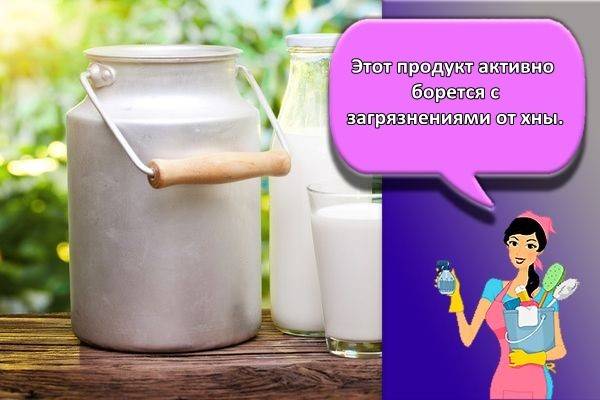
Milk
This product actively fights off henna contamination. The milk is heated to 50 ° C. Then the stain is soaked in it for 30 - 40 minutes. After that, powder is poured into the processing site and rubbed into the fabric. Leave for 20 minutes, then wash in cold water.
Household chemicals
Active oxygen products
It contains active enzymes that fight any type of pollution. Before use, the fabric is soaked in soapy water. Then they are treated with a product and washed in cold water.
Oxygen Bleach Powder
This product is suitable for white and light colored clothes. Prepare a mushy mixture with water. Apply to the stain and leave for 30 minutes. Leaving the mixture on the fabric, wash with powder.
Palmyra
This composition is sold in any household chemicals store at an affordable price. Produced in the form of a paste. Palmyra is applied to the stain and kept according to the instructions and the type of fabric.

Amway
It is an effective stain remover that removes any stains. The tool has a high price, but it fully justifies it. Suitable for any type of clothing. It is produced by an American company. If you manage to smear an expensive item that is a pity to throw away, then Amway will help you save it.
Ammonia
Add 1 tablespoon to a glass of water. solution. Then gently apply to the stain with a cotton pad or stick. Leave for 30 minutes. Old stains are treated undiluted with ammonia. The method is suitable for light and white fabrics.
Toothpaste
The advantages of this method are that it can be applied to any type of fabric. But its effectiveness is achieved only with repeated use or on fresh dirt. The paste is applied to the stain and kept for 30 minutes. Then the clothes are soaked in soapy water and washed in cold water.
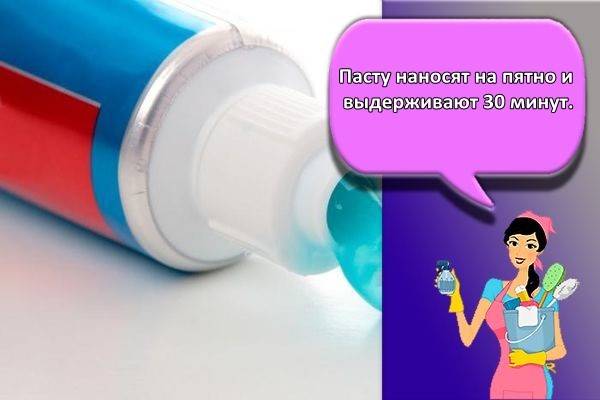
Suitable for all types of fabrics. The method is effective when the henna has not yet had time to dry. Dry baking soda is poured onto the stain.
Features of removing soot stains
It will not work to remove the fumes from clothes with ordinary detergents, but you should also not rush to throw away your favorite thing. Contamination can be eliminated if you act quickly and correctly. You should not resort to the help of the usual washing powder, which is intended for routine cleaning, as it will make the shade of the stain even brighter.This is due to the fact that the resinous elements present in the composition of the pollution, reacting with the detergent components, change their structure and then it will be almost impossible to remove soot from the fabric.
Key recommendations:
- It is worth starting to remove it immediately after the appearance of the stain, since old contamination is difficult to clean.
- Before using aggressive components, it is necessary to first test the tissue resistance to them. To do this, apply the solution in an inconspicuous place and wait 2-3 minutes. If the shade remains the same, and the fibers are not deformed, then you can start cleaning.
- When removing under the cloth, place an absorbent layer that can absorb excess cleaning solution.
- When cleaning, the movements should be directed from the edge of the spot to the center.
- After using the cleaning agent, you need to wash the item completely by hand.
- When removing soot, you need to be prepared for the fact that the first time you will not be able to completely remove the stain. Then the procedure should be repeated or use a different method.
General recommendations
- So that you do not have to painfully search for how you can remove the traces of the berries, react in a timely manner to what is happening. Don't let the cherry tree go deep. Remove clothing and rinse under running warm water.
- It is better not to use soap at the initial stage of the fight against pollution, only running water.
- A cloth will help to remove the peel and small particles. The fabric should be natural and colorless. Do not use products that, at least in theory, can dye your clothes.
- Professional stain removers should not touch the fabric for more than 50-6 minutes
- Movements must be neat. No need to scrape with your fingernail. So you will only "impress" the juice from the bird cherry, let it penetrate deep into the pile.
- Move the cloth from the periphery to the center of the dirt. Failure to do so may result in the spread of the stain.
If you take note of these points, the question of how to wash the berries will become irrelevant.
How to wash colored clothes
Not all products are suitable for colored clothes. So, do not take concentrated bleaches or substances with a strong active ingredient. Otherwise, white marks will appear on the clothes in the place where the cherry juice stains were.
Glycerol
Colored clothes will not shed if traces of cherries are treated with glycerin and egg yolk. All ingredients are mixed and applied to the stain. After 2 hours, the clothes are washed.
Laundry soap
The contaminated place is moistened with water and rubbed with laundry soap. After half an hour, the soap must be washed off. If the spot does not become brighter, the process is repeated several more times. This option is suitable for both denim and delicate materials.
How to remove tar from clothes: basic methods
In order to safely get rid of resin traces on clothes, it is important to know what you should not do in this case:
- try to wipe the stain with your hands;
- immediately wash the soiled thing in the machine or by hand;
- use solvents, bleaches and other means without figuring out whether they can be used for this type of fabric.
If the speck is completely fresh and has not yet had time to be absorbed into the fabric, it is quite easy to deal with it. For this you need:
- do not wipe off dirt protruding above the surface;
- moisten the fabric on the back and around the stain with cold water;
- place in a cool place until the resin hardens;
- With the blunt side of a knife, carefully remove the hardened resin drop.
To remove fresh, but already absorbed tar stains from clothes, you will need:
- Sharp knife.
- Plastic bag with ice.
- Scotch.
- Iron.
Procedure:
with a sharp knife, carefully remove the remaining resin from the product;
if the item is small, wrap it in a plastic bag and place it in the freezer for 2 hours, and for a large item, use ice, putting it in a plastic bag on a tar stain and leaving it at the same time;
rub the frozen dirt with your hands so as to crumble the resin into pieces;
carefully scrape off the remains with the blunt side of a knife;
remove the rest with scotch tape;
place the injured thing on a flat surface, placing a piece of clean cloth under the stain, and also covering it with a cloth or paper napkins on top;
iron the dirty area several times with a hot iron to with clothes resin switched to cloth or napkins;
if necessary, replace the backing and repeat the procedure.
Resin can be easily removed from leather or leatherette items as follows:
- any vegetable oil with a sponge or cotton pad, apply to the contaminated area and soak it;
- leave for 10 minutes;
- rub with a piece of clean cloth;
- Remove grease by using dishwashing detergent or alcohol.
When using the same method to clean woven garments after being soaked in oil, the affected area should be:
- rinse in hot water;
- rub with laundry soap or dishwashing detergent;
- withstand this for several minutes;
- wash automatically or manually.
As a cleanser, you can use a mixture of 1 tbsp. l. potato starch, 4 drops of ammitac and 4 drops of turpentine:
- apply the composition to the stained area;
- leave to dry completely;
- remove residues of dry product with a stiff brush;
- repeat the procedure if necessary.
For some things, this cleaning method is also suitable:
- soak the product in stain remover or cola for 1 hour;
- wash in a washing machine.
Using stain removers

There are now a wide range of stain removers available in hardware stores with different characteristics. Some successfully cope with complex and old stains, while others cannot remove even the simplest stains. Therefore, it is difficult to understand the quality of a tool without special knowledge.
Important!
When buying a stain remover, be sure to take into account its composition. Products with harsh ingredients are not suitable for all fabrics. Such substances are applied only to the stain in a small amount.
When choosing a stain remover, you need to know that there is no effective universal remedy that equally well copes with stains of different origins on all types of fabric. Usually, the advertised products either do not cope well with dirt, or have an aggressive composition that is not suitable for cleaning delicate fabrics.
When using stain removers, it is important to read the instructions carefully and follow them exactly. Do not increase the amount of the product, the concentration of the solution or the holding time.
Also, you should not try to get rid of stains on clothes if, according to the instructions, the use of a stain remover is prohibited on such fabric.
General tips for removing stubborn stains
First of all, you need to remember once and for all that heavily soiled things, as well as those that have complex or persistent dirt, must be processed as early as possible. As a rule, before washing, all stains are removed, after which the soiled item can be additionally soaked for a while and only then sent to the wash. Sometimes white natural fabrics have to be boiled down, because even after all the procedures carried out, visible dirty or yellow traces remain on the fabric.
Before using any stain remover, you need to check its action from the wrong side of the fabric, in an inconspicuous place.
On delicate fabrics, special care should be taken to remove stubborn dirt.
To know exactly what material you have to work with, use the information on the product label.
Usually, dirty traces are removed by first laying a pad of folded paper towels under the stained place. The product is first applied to the edges of the stain and smoothly, without smearing it on the surface, move to its center
This way you will avoid streaking.
In difficult cases, you will have to reapply the cleanser, that is, repeat the procedure.

